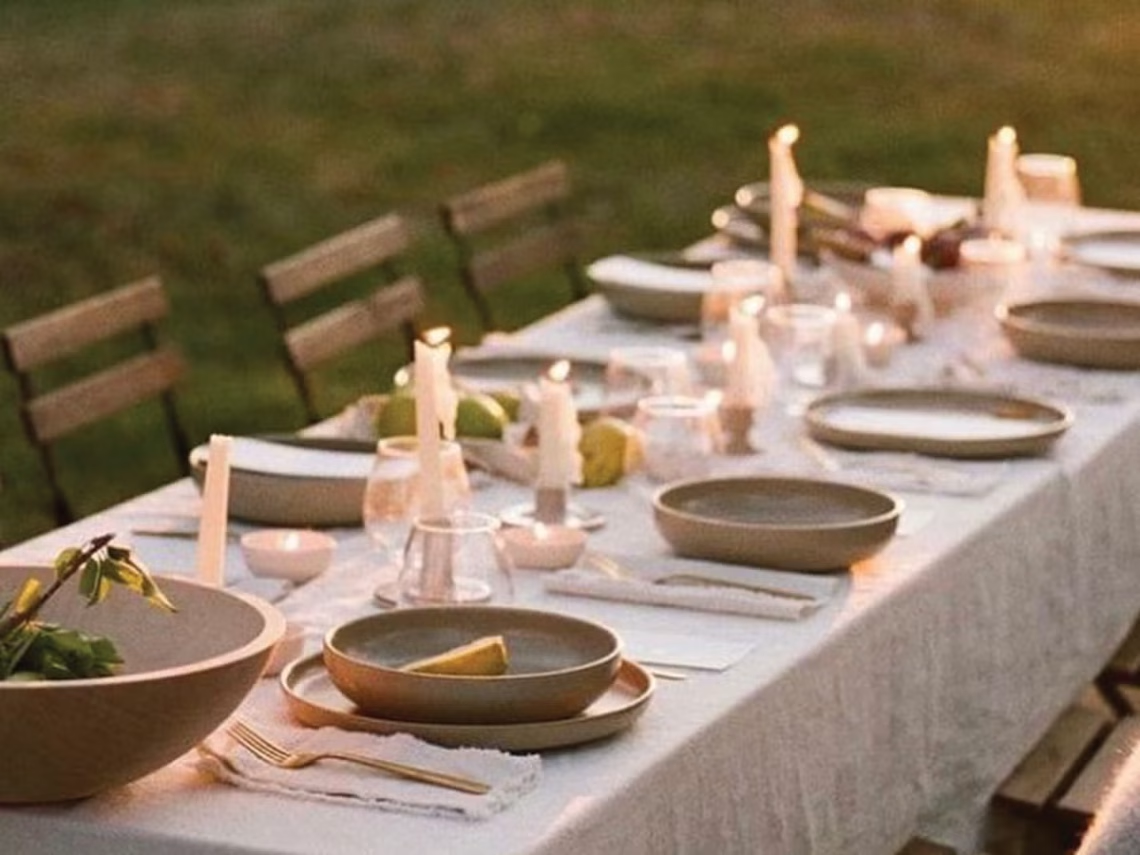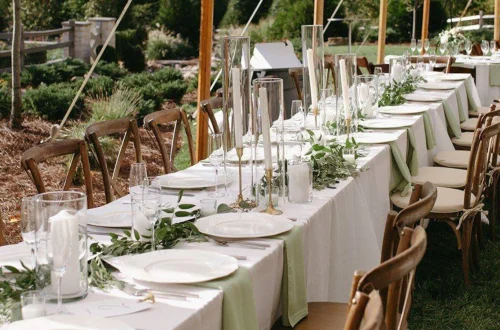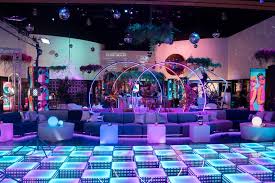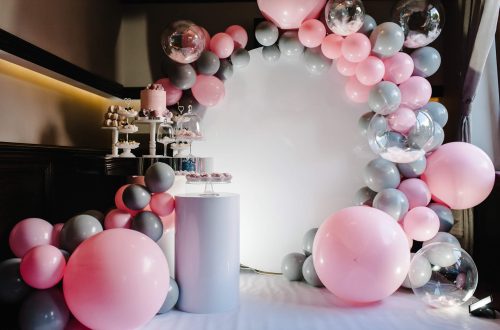Tablescaping is the art of creating a mood and telling a story through your table settings. It’s about more than just placing dishes on a table – it’s about crafting an experience that engages your guests’ senses and creates memorable moments. A thoughtfully designed tablescape serves as both the backdrop for your celebration and a reflection of your personal style and the spirit of the occasion. This comprehensive guide will explore five distinct themes that can transform your dining experience, each carefully designed to create a specific atmosphere and mood. From rustic charm to modern elegance, each theme offers unique elements that can be adapted to suit your taste and the formality of your event. The right tablescape doesn’t have to be expensive or overly elaborate – it’s about creating a cohesive, intentional design that enhances the joy of gathering around the table with friends and family.
Theme 1: Rustic Farmhouse
The rustic farmhouse theme celebrates casual elegance with natural elements and comfortable, lived-in beauty. This approachable style creates a warm, inviting atmosphere that’s perfect for family gatherings and relaxed celebrations.
Table Elements:
- Linen Runner: Use natural linen in cream, beige, or soft gray to create a neutral base that allows other elements to shine.
- Wood Slice Chargers: These organic elements bring the outdoors inside and add textural interest to your place settings.
- Simple White Plates: Classic white ceramics provide a clean backdrop that complements the natural elements of the theme.
- Mason Jar Glasses: These versatile vessels work as water glasses or can be used for small floral arrangements.
- Rustic Centerpiece: A garland of fresh herbs, wildflowers, or eucalyptus creates a beautiful, continuous centerpiece that feels organic and unstructured.
Accessories: Incorporate burlap napkins, mason jar votives with tea lights, and small potted herbs as place card holders to complete the rustic farmhouse look.
Color Palette:
Stick to earthy, muted colors like cream, sage green, dusty blue, and soft grays. These hues create a calming, natural atmosphere that feels connected to the seasons.
Introduce pops of color through seasonal elements like sunflowers in summer or autumn leaves in fall, allowing your tablescape to evolve with the time of year.
Theme 2: Modern Minimalist
The modern minimalist theme emphasizes clean lines, negative space, and sophisticated simplicity. This style creates a calm, elegant atmosphere that allows the food and conversation to be the primary focus.
Design Elements:
- No Tablecloth: Let the natural beauty of your table surface contribute to the minimalist aesthetic, whether it’s wood, glass, or metal.
- Sleek Placemats: Use simple placemats in solid colors like white, black, or soft gray to define each place setting without overcrowding the table.
- Matte Black or White Ceramic: Choose plates with clean, simple shapes and textured finishes that add visual interest without complexity.
- Simple Glassware: Opt for clear glassware with clean lines that won’t compete with the food presentation.
- Sculptural Centerpiece: A single branch, clean geometric sculpture, or a simple bowl with interesting objects creates focus without overwhelming the space.
Color Scheme:
Focus on neutral colors with occasional subtle accents. Think whites, grays, black, and soft beiges. If adding color, keep it muted and use it sparingly – perhaps in the napkins or a single statement piece.
Minimalist Principle: The key to this theme is “less is more.” Each element should be intentional and contribute to the overall aesthetic without creating visual clutter.
Theme 3: Bohemian Chic
The bohemian chic theme embraces an eclectic, collected-over-time aesthetic that’s both artistic and comfortable. This style celebrates individuality and allows for creative expression through mixed patterns and textures.
Boho Elements:
- Macrame Runner: A handcrafted macrame runner adds texture and bohemian flair while serving as a beautiful backdrop for other elements.
- Mixed-and-Matched Dishes: Use plates with different patterns but in complementary colors to create visual interest and an authentic “collected” feel.
- Colored Glassware: Incorporate glasses in jewel tones or unique shapes that add personality to the table.
- Multiple Bud Vases: Use several small vases with pampas grass, dried florals, or single stems to create an organic, unplanned look.
- Layered Textures: Combine different fabrics, metals, and natural elements for a rich, collected appearance.
Color and Pattern:
Embrace jewel tones like emerald green, deep purple, and warm gold, combined with earthy neutrals. Mix patterns freely but keep them within a similar color family to maintain harmony.
Consider incorporating global influences through textiles, ceramic dishes from different cultures, or handcrafted elements that tell a story.
Boho Balance: While embracing eclecticism, ensure there’s a unifying element – such as a consistent color family or material – to prevent the table from looking like random objects placed together.
Theme 4: Coastal Grandmother
The coastal grandmother aesthetic celebrates timeless elegance with a relaxed, beachy feel. This theme is about creating a sophisticated yet comfortable atmosphere that evokes the serenity of the ocean.
Coastal Elements:
- Blue and White Palette: Classic combinations like navy and white or soft blue and cream create an instantly relaxing coastal atmosphere.
- Woven Hyacinth Placemats: These natural fiber placemats add texture while maintaining the easygoing coastal feel.
- Classic Dinnerware: Use timeless patterns like toile, stripes, or simple solid colors that feel familiar and comforting.
- Nautical Accents: Subtle elements like rope details, shell accents, or simple anchor motifs add to the theme without being overly literal.
- White Hydrangea Centerpiece: Fresh white hydrangeas or other coastal flowers create an elegant, serene centerpiece.
Mood and Ambiance:
The coastal grandmother style is about creating a sense of calm sophistication. The colors should be soft and soothing, reminiscent of ocean breezes and sandy shores.
Include natural elements like sea glass, shells, or driftwood in moderation to enhance the coastal theme without overwhelming the sophisticated aesthetic.
Theme 5: Tropical Getaway
The tropical getaway theme brings the vibrant, lush feeling of an exotic vacation to your dining table. This style is all about creating excitement and a sense of escape from everyday life.
Tropical Elements:
- Large Monstera Leaves: Use these iconic tropical plants as placemats or for scattered accents. Artificial versions work well and can be reused.
- Brightly Colored Napkins: Choose napkins in tropical colors like coral, turquoise, or sunny yellow to inject energy into the table.
- Bamboo-Style Cutlery: Natural materials like bamboo or rattan cutlery complement the tropical aesthetic while being environmentally friendly.
- Pineapple Centerpiece: A whole pineapple or pineapple slices can serve as both decoration and a conversation starter.
- Collection of Tropical Fruits: Scatter mangoes, lemons, or other tropical fruits throughout the table for natural color and fragrance.
Color and Atmosphere:
Embrace bold colors like vibrant greens, sunny yellows, and bright oranges that evoke tropical flowers and exotic landscapes. The palette should feel energetic and joyful.
Consider incorporating tropical scents through candles with coconut or tropical fruit fragrances, but keep them subtle enough not to compete with food aromas.
Tropical Tip: Include natural textures like woven placemats, wooden serving pieces, and natural fiber napkins to reinforce the tropical, organic feel.
Implementing Your Chosen Theme
Successfully executing any tablescape theme requires attention to detail and understanding of how different elements work together to create a cohesive look.
Layering Principles:
Start with a base layer (tablecloth or placemats), add your dinnerware, then incorporate your glassware, flatware, and finally decorative elements. Each layer should build on the previous one without overwhelming the overall design.
Consider the height of elements – vary heights throughout the table to create visual interest, but ensure centerpieces don’t block conversation or sight lines across the table.
Practical Considerations:
- Functionality: Ensure your design doesn’t impede the dining experience. Guests should be able to easily reach food and engage in conversation.
- Durability: Choose elements that can withstand the practical needs of dining, such as washable napkins and sturdy serving pieces.
- Budget-Friendliness: Theme elements can be created with a mix of special occasion pieces and everyday items cleverly arranged.
- Seasonal Adaptation: Adapt your chosen theme to incorporate seasonal elements for a fresh, timely look.
Customizing Themes for Different Occasions
Each of these themes can be adapted for various types of celebrations and events, from casual family dinners to formal entertaining.
Formal Adaptations:
For more formal occasions, add elements like cloth napkins with napkin rings, additional glassware for wine, and more elaborate centerpieces. Maintain the core theme elements while adding sophistication through higher-end materials or more refined execution.
Casual Adaptations:
For casual gatherings, simplify elements while keeping core theme colors and textures. Use paper napkins instead of cloth, simpler serving pieces, and DIY elements that maintain the theme’s spirit without requiring extensive preparation.
Event-Specific Adjustments: Consider the formality of your event, your guests’ preferences, and the type of food being served when customizing your tablescape theme.
Creating Your Own Personal Style
While these themes provide starting points, the most successful tablescapes reflect your personal aesthetic and the unique spirit of your gathering.
Developing Your Style:
Pay attention to what colors, textures, and elements make you feel comfortable and excited. Your personal style will emerge through repeated experimentation with different elements and combinations.
Start with one theme that appeals to you and gradually incorporate elements from other themes that resonate with your aesthetic preferences.
Signature Elements: Develop a few signature touches that become associated with your entertaining style, such as a particular type of centerpiece, napkin fold, or color combination.
Conclusion
Reminding readers that the best tablescape is simply a thoughtful expression of the host’s style and the spirit of the occasion, these five themes provide starting points for creating beautiful, memorable dining experiences. The key to successful tablescaping is not perfection but rather the thoughtful incorporation of elements that create a welcoming, aesthetically pleasing environment.
Remember that the most important aspect of any gathering is the sense of welcome and community you create for your guests. The tablescape is simply the beautiful backdrop for the connections and memories that will be made around your table.
Don’t be afraid to experiment with different themes and elements. Each occasion provides an opportunity to refine your personal style and discover what creates the atmosphere you want for your guests.
Whether you prefer the relaxed charm of a rustic farmhouse setting or the sophisticated elegance of a minimalist table, the most important element is that your tablescape reflects your personality and enhances the joy of sharing a meal with others.
With these five themes as inspiration, you’re equipped to create tablescapes that will make any celebration special and memorable for you and your guests.





